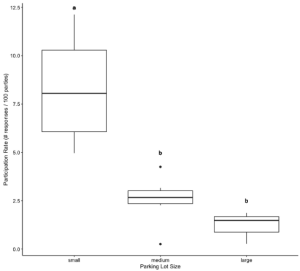A Text-Messaging Chatbot to Support Outdoor Recreation Monitoring Through Community Science
Citation
Lia, E. H., Derrien, M. M., Winder, S. G., White, E. M., & Wood, S. A. (2023). A text-messaging chatbot to support outdoor recreation monitoring through community science. Digital Geography and Society, 5, 100059. https://doi.org/10.1016/j.diggeo.2023.100059
Abstract

Public land managers depend on reliable and readily available data about outdoor recreation in parks and greenspaces. However, traditional recreation monitoring techniques including visitor surveying and counting cannot be implemented over large spatial and temporal scales, especially in remote and undeveloped settings where monitoring is costly. To fill these data gaps, and thereby inform decision-making, this study develops and tests the efficacy of a novel recreation monitoring technique that engages visitors in data collection using a chatbot and text-messages. Drawing on knowledge and methods from community science and crowdsourcing, we present a relatively low-cost and low-barrier approach to counting and characterizing recreational visits on public lands. In an 18-month pilot implementation on a national forest in Washington, USA, we found that crowdsourced data collected using the chatbot were consistent with results of controlled counts and in-person surveys. Furthermore, some sites received relatively high participation rates, up to 12% of recreating parties, regardless of cellular connectivity at the site. This study, which is the first to engage public land usersin community science using a text-messaging chatbot for the purposes of studying outdoor recreation, demonstrates the potential for technology to support new community science approaches that involve visitors in land stewardship and the development of recreation monitoring systems.